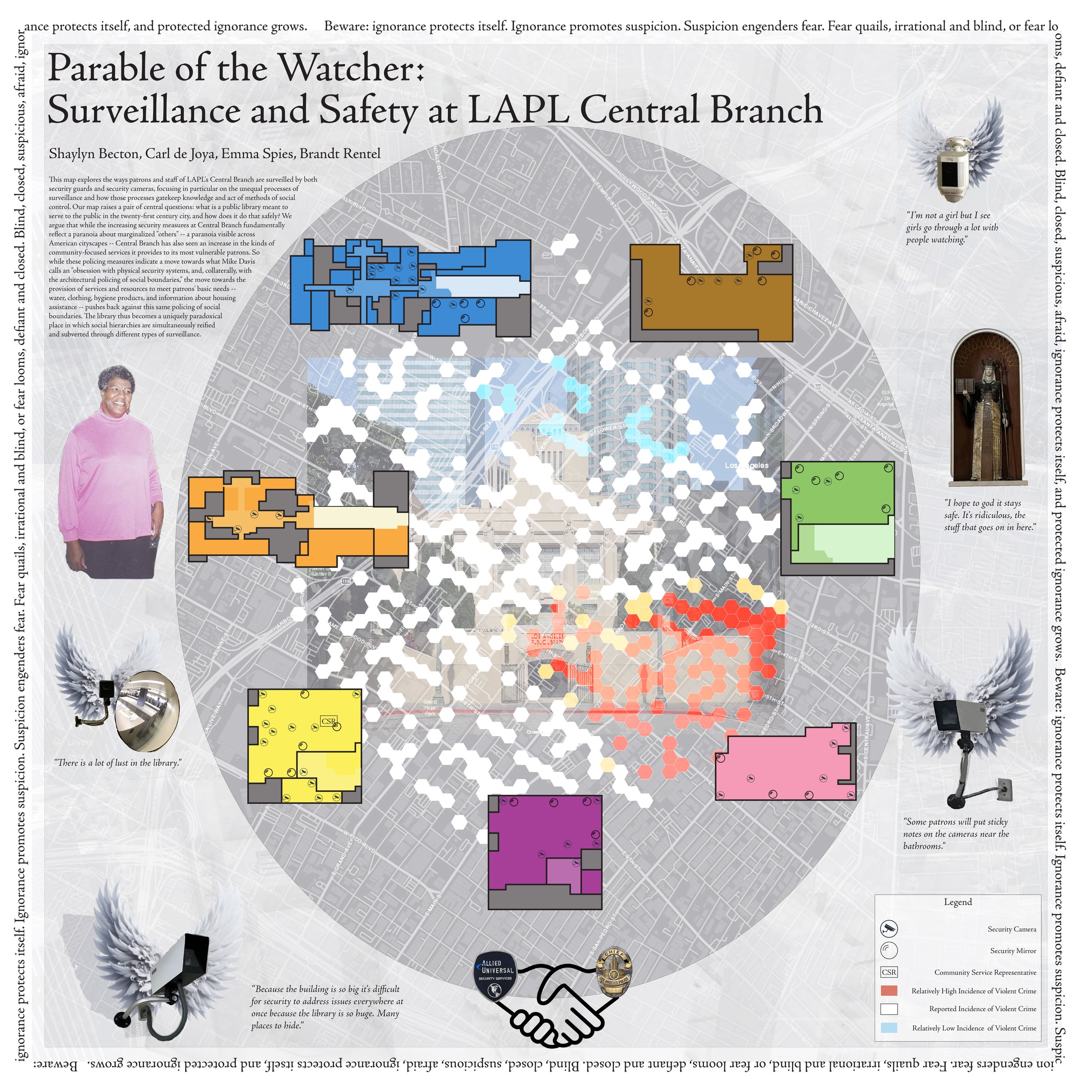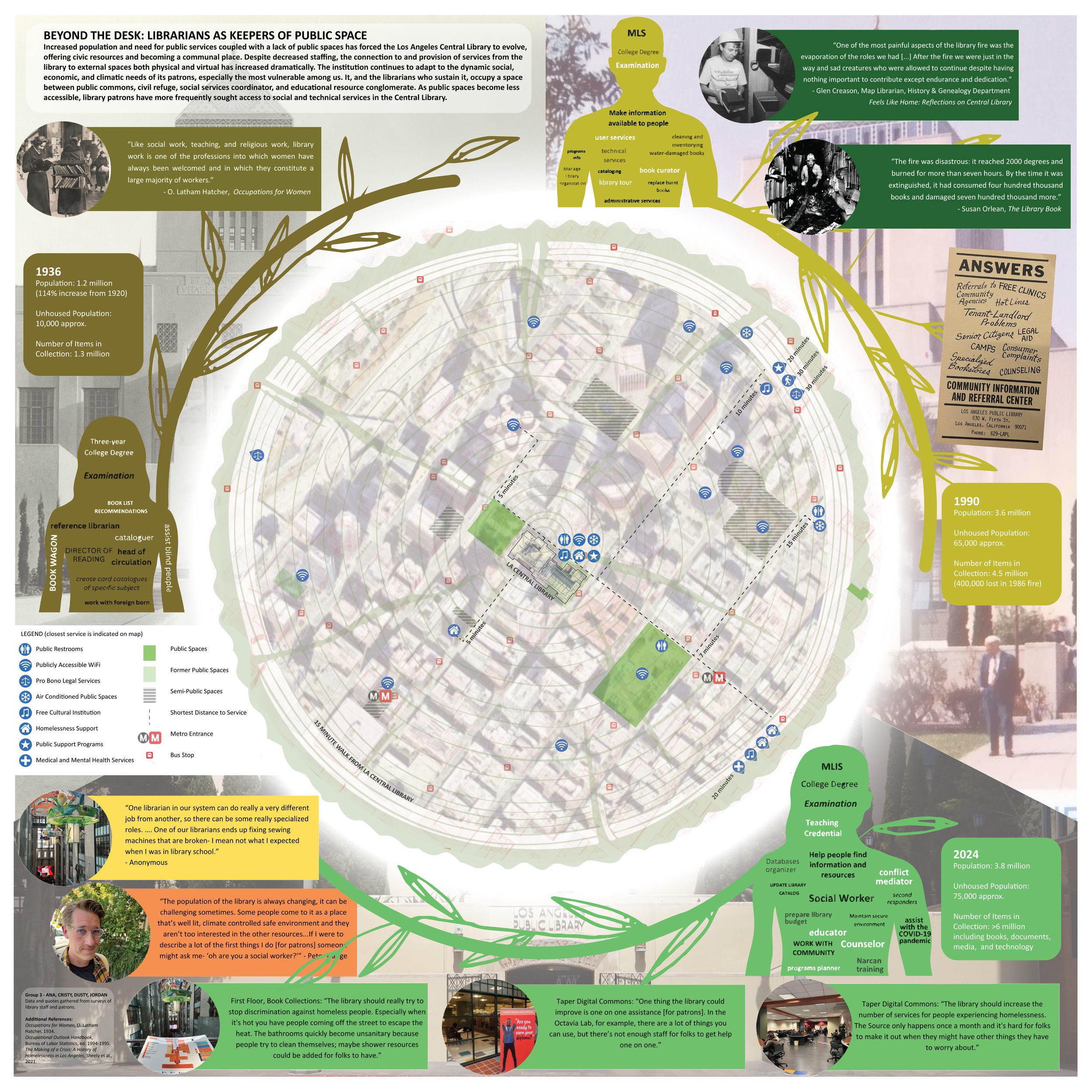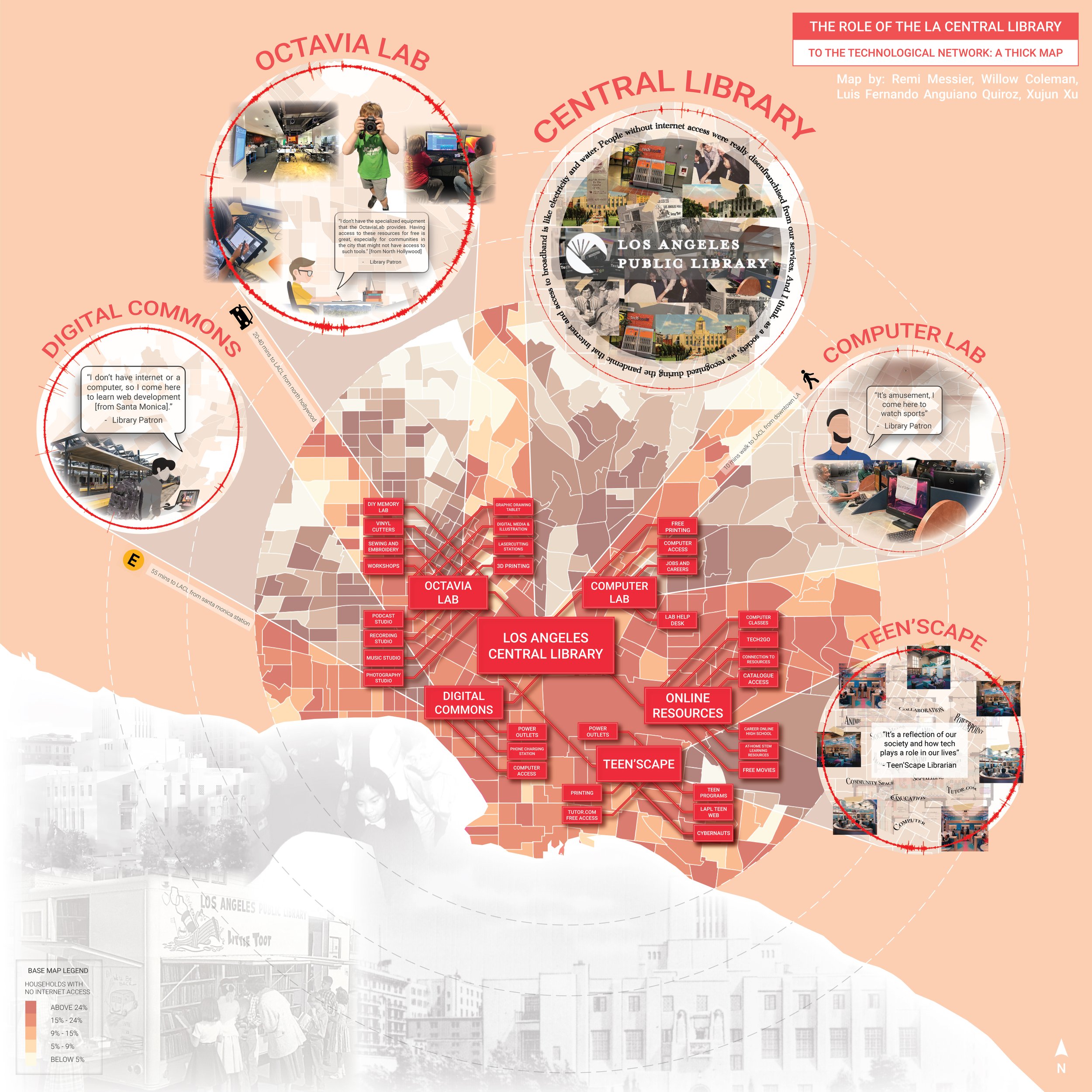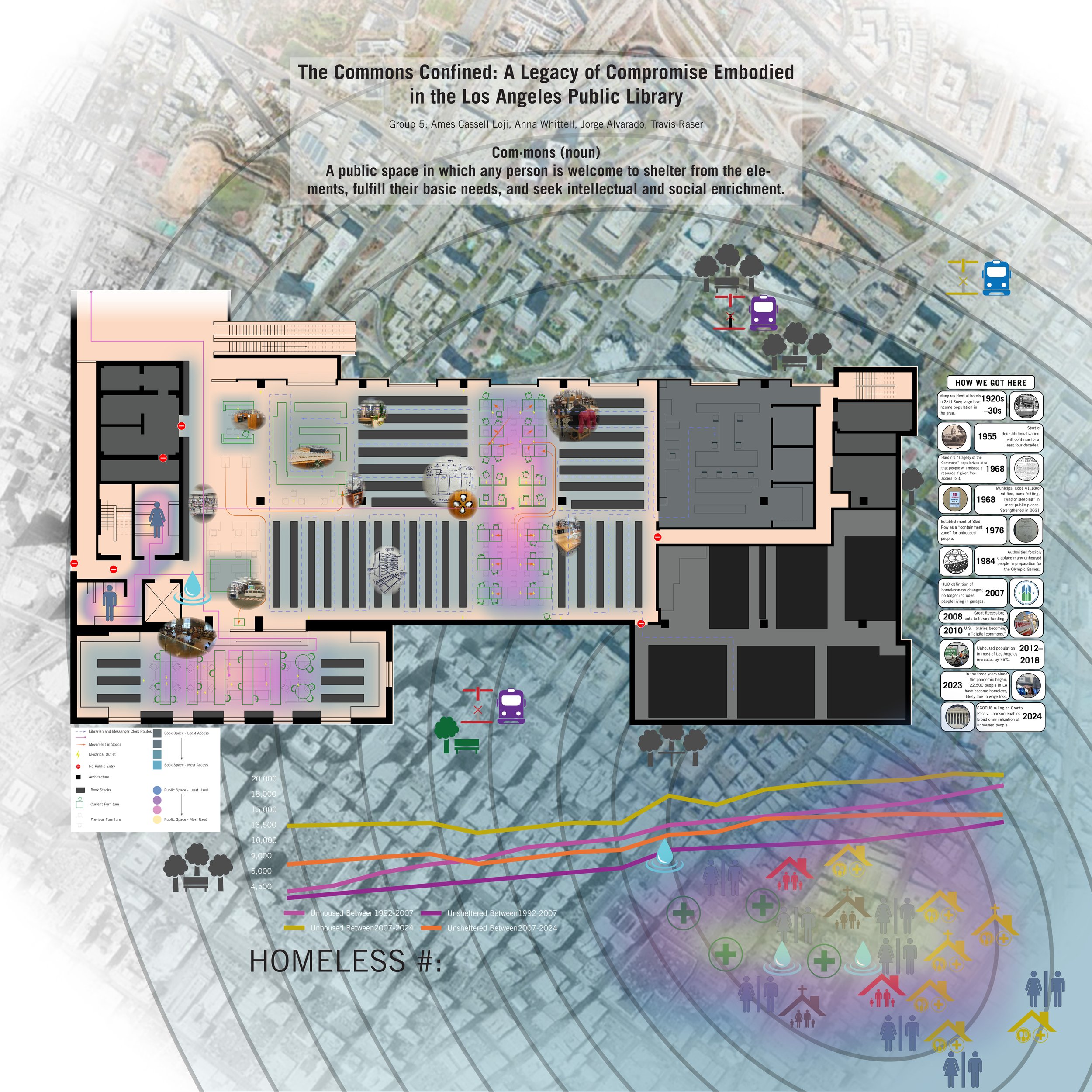Summer Institute 2024
Downtown LA Commons: Past, Present, Future
Instructors: Gus Wendel, Claire Nelischer, Doga Tekin
Students: UHI 2024-25 Cohort
Los Angeles Public Library - Central Branch
The 2024 Summer Institute launched our investigation of the year’s overarching theme of Downtown LA Commons: Past, Present, Future in collaboration with the Los Angeles Public Library (LAPL). Leveraging LAPL’s deep history and vital presence in Downtown LA, as well as its role as a hub for essential public services, students concentrated their “thick mapping” projects on the Central Library branch and its surrounding areas. Student inquiries were driven by the overarching question(s):
Who and where is the public in the public library?
Given that libraries represent one of the few remaining public institutions in U.S. cities, what is the promise of the library for providing common spaces and shared knowledge?
What can the history of the LAPL Central Branch tell us about both the challenges the library has faced in the past as well as the changing role of the library as a public service and space in the future?
With guidance from our teaching team and support from LAPL staff, students employed diverse methodologies, including archival research, spatial analysis, and sensory. LAPL staff members acted as both research facilitators—helping students navigate the library’s extensive resources—and as vital contributors with lived experience, offering insight into the library’s operations and its impact as a public institution.
Over the course of the Institute, students created detailed thick maps, which they presented to LAPL staff and the UHI teaching team. These public-facing projects serve as valuable resources for exploring the library’s role in shaping Downtown Los Angeles. Through their work, students examined critical questions surrounding ethics, power, and the evolving definition of what it means to be a public-serving institution in Los Angeles today and in the future.

Parable of the Watcher: Surveillance and Safety at LAPL Central Branch
UHI Summer Institute 2024
Students: Shaylyn Becton, Carl de Joya, Emma Spies, Brandt Rentel
This map explores the ways patrons and staff of LAPL's Central Branch are surveilled by both security guards and security cameras, focusing in particular on the unequal processes of surveillance and how those processes gatekeep knowledge and act of methods of social control. Our map raises a pair of central questions: what is a public library meant to serve to the public in the twenty-first century city, and how does it do that safely? We argue that while the increasing security measures at Central Branch fundamentally reflect a paranoia about marginalized "others" -- a paranoia visible across American cityscapes -- Central Branch has also seen an increase in the kinds of community-focused services it provides to its most vulnerable patrons. So while these policing measures indicate a move towards what Mike Davis calls an "obsession with physical security systems, and, collaterally, with the architectural policing of social boundaries," the move towards the provision of services and resources to meet patrons' basic needs -- water, clothing, hygiene products, and information about housing assistance -- pushes back against this same policing of social boundaries. The library thus becomes a uniquely paradoxical place in which social hierarchies are simultaneously reified and subverted through different types of surveillance.

Embodied Mapping
UHI Summer Institute 2024
Students: Cora Johnson-Grau, Hollis Potts, Ángela Godoy-Fernández, Sydney Patterson
The library is a space/place rooted in colonial meaning-making and also contains the possibility of re-imagining and liberation. Drawing on the lens of Black and Indigenous theorists and educators, educating our youth is fundamentally political (Mckittrick, 2020; hooks, 1994; Freire 1970). Our projects is a resource guide and a pedagogical tool for educators/caretakers of our youth locating indigenous presence, erasure, and knowledge in the Central Branch of the Los Angeles Public Library using resources readily available to the public. Our project engages with the library’s history as a polyvocal political project that is constantly revisioning and renegotiating who the public that it serves is. Out thick map is in resistance and speculation with educators by locating the act of mapping as refusal and re-imagining space, knowledge, and power.

Beyond the Desk: Librarians as Keepers of Public Space
UHI Summer Institute 2024
Students: Ana K. Arreguin Gómez, Cristy Portlock, Dusty Frye, Jordan Wynne
Increased population and need for public services coupled with a lack of public spaces has forced the Los Angeles Central Library to evolve, offering civic resources and becoming a communal place. Despite decreased staffing, the connection to and provision of services from the library to external spaces both physical and virtual had increased dramatically. The institution continues to adapt to the dynamic social, economic, and climatic needs of its patrons, especially the most vulnerable among us. It, and the librarians who sustain it, occupy a space between public commons, civil refuge, social services coordinator, and educational resource conglomerate. As public spaces become less accessible, library patrons have more frequently sought access to social and technical services in the Central Library.

The Role of the LA Central Library
To the Technological Network: A Thick Map
UHI Summer Institute 2024
Students: Remi Messier, Willow Coleman, Luis Fernando Anguiano Quiroz, Xujun Xu

The Commons Confined: A Legacy of Compromise Embodied in the Los Angeles Public Library
UHI Summer Institute 2024
Students: Ames Cassell Loji, Anna Whittell, Jorge Alvarado, Travis Raser
By thickening the layout of the International Languages department in the LAPL Central Branch, our map illustrates that the erosion of the commons in the city of Los Angeles manifests materially in the library’s arrangement of furniture and resources, even in a single department. In the absence of other common spaces, the library will continue serving as the default public commons in DTLA. This shift in its function demands a significant rethinking and restructuring of how the library views and performs its role. We have collected a range of qualitative data about the layout, functions, and patrons of the library: We interviewed librarians, observed the design and use of the space, and performed historical research into original architectural plans and the history of downtown. By displaying the changes that have occurred in both the library and the surrounding area over several decades, our map shows that the same forces which confine a large proportion of LA’s unhoused population to Skid Row have also required librarianship to encompass a much broader array of responsibilities and pressures than was historically the case. Our comparative analysis of interviews and observational data with original planning documents sheds light on the ad hoc spatial reconfigurations that library staff make to better manage the tensions between the differing needs of their multiple stakeholders; in many cases, we found, these reconfigurations erode patrons’ autonomy, even as librarians overwhelmingly express enthusiasm for making services more varied and accessible to all. Thus, library staff must constantly negotiate between diametrically opposed values: a fundamentally unsustainable condition.
